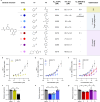Selective CBP/EP300 Bromodomain Inhibitors: Novel Epigenetic Tools to Counter TNF-α-Driven Inflammation
- PMID: 40575322
- PMCID: PMC12188386
- DOI: 10.1021/jacsau.5c00085
Selective CBP/EP300 Bromodomain Inhibitors: Novel Epigenetic Tools to Counter TNF-α-Driven Inflammation
Abstract
Tumor necrosis factor α (TNF-α) is a central driver of inflammation in autoimmune conditions such as Crohn's disease and rheumatoid arthritis (RA). Targeting epigenetic regulators involved in cytokine expression holds therapeutic promise, yet the precise role of the CBP/EP300 bromodomains (BRDs) in modulating immune responses remains poorly understood. Here, we introduce a distinct class of selective CBP/EP300-BRD inhibitors based on a unique 3-methylcinnoline acetyl-lysine mimic, identified through high-throughput fragment docking. These inhibitors significantly reduce TNF-α-driven cytokine expression in vitro by blocking NFκB signaling in immune cells. In vivo, BRD inhibition led to a robust anti-inflammatory effect, decreasing cytokine secretion (including IL-1β, MCP-1, IL-1α, and IL-6) and preventing immune cell migration to inflamed lymph nodes in a TNF-α-stimulated murine model. Our findings highlight CBP/EP300-BRDs as promising targets for autoimmune therapy, with these non-cytotoxic inhibitors offering a potential complementary approach for RA and other TNF-α-mediated inflammatory conditions.
Keywords: CBP/EP300; NFκB; TNF-α; bromodomain inhibitors; epigenetics; inflammation.
© 2025 The Authors. Published by American Chemical Society.
Figures




Similar articles
-
A systematic review and economic evaluation of the use of tumour necrosis factor-alpha (TNF-α) inhibitors, adalimumab and infliximab, for Crohn's disease.Health Technol Assess. 2011 Feb;15(6):1-244. doi: 10.3310/hta15060. Health Technol Assess. 2011. PMID: 21291629 Free PMC article.
-
Systemic pharmacological treatments for chronic plaque psoriasis: a network meta-analysis.Cochrane Database Syst Rev. 2017 Dec 22;12(12):CD011535. doi: 10.1002/14651858.CD011535.pub2. Cochrane Database Syst Rev. 2017. Update in: Cochrane Database Syst Rev. 2020 Jan 9;1:CD011535. doi: 10.1002/14651858.CD011535.pub3. PMID: 29271481 Free PMC article. Updated.
-
Systemic pharmacological treatments for chronic plaque psoriasis: a network meta-analysis.Cochrane Database Syst Rev. 2021 Apr 19;4(4):CD011535. doi: 10.1002/14651858.CD011535.pub4. Cochrane Database Syst Rev. 2021. Update in: Cochrane Database Syst Rev. 2022 May 23;5:CD011535. doi: 10.1002/14651858.CD011535.pub5. PMID: 33871055 Free PMC article. Updated.
-
A systematic review of the effectiveness of adalimumab, etanercept and infliximab for the treatment of rheumatoid arthritis in adults and an economic evaluation of their cost-effectiveness.Health Technol Assess. 2006 Nov;10(42):iii-iv, xi-xiii, 1-229. doi: 10.3310/hta10420. Health Technol Assess. 2006. PMID: 17049139
-
The effect of immunomodulatory properties of naringenin on the inhibition of inflammation and oxidative stress in autoimmune disease models: a systematic review and meta-analysis of preclinical evidence.Inflamm Res. 2022 Nov;71(10-11):1127-1142. doi: 10.1007/s00011-022-01599-7. Epub 2022 Jul 8. Inflamm Res. 2022. PMID: 35804246
References
-
- Furman D., Campisi J., Verdin E., Carrera-Bastos P., Targ S., Franceschi C., Ferrucci L., Gilroy D. W., Fasano A., Miller G. W., Miller A. H., Mantovani A., Weyand C. M., Barzilai N., Goronzy J. J., Rando T. A., Effros R. B., Lucia A., Kleinstreuer N., Slavich G. M.. Chronic Inflammation in the Etiology of Disease across the Life Span. Nat. Med. 2019;25(12):1822–1832. doi: 10.1038/s41591-019-0675-0. - DOI - PMC - PubMed
LinkOut - more resources
Full Text Sources
Miscellaneous
